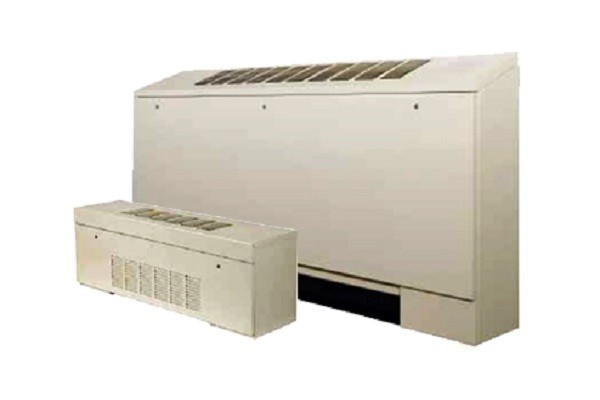
Understanding Fan Coil Units
In the HVAC industry, “Fan Coil Unit” is a term that relates to the most inexpensive way to heat or cool a space. If an “indoor air handler” is a “direct drive unit”, it should be considered a fan coil unit. Here are the pros and cons of heating and cooling with fan coil units.
Pros:
- Often the most inexpensive way to heat or cool a small space
- No matter where it’s located: ceiling, wall, or exposed; the units require little or no ducting
- Each individual area that is fed by a fan coil unit can be temperature and air volume controlled
Cons:
- Because they are direct drive type, the fan usually can’t handle air resistance and elaborate ductwork designs
- Units are close to proximity of people, so local noise can be a problem
- Air distribution can be problematic as space may require more even distribution
Ceiling units:
There are numerous designs of ceiling mounted fan coil units. These units can be located above a dropped ceiling or can be exposed within the conditioned space. Here’s a look at the most prominent designs.
- Basic Horizontal Unit
This unit is the least costly, because it is the basic model of a unit that can ventilate, cool, and/or heat. Its main components are either a two-pipe or four- pipe coil and an open fan and direct drive motor. These units don’t include an insulated cabinet or include filtration. Normally filters are located just above the inlet to the plenum area above the ceiling. There is no ductwork to the back of a basic unit, and the supply ductwork is off the front of the unit.
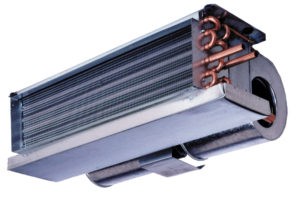
- Return Plenum Unit
This unit is the same as the basic horizontal unit above, except it has an insulated housing around the blower and motor, and the plenum (insulated box) has a filter. It also allows for incoming ductwork in the bottom or the back of the unit.
- Telescoping Flush Mounted Unit:
This unit is also the same internally as the basic unit, except it has a decorative bottom with a return grille that eliminates incoming ductwork and a filter is supplied. There is also a hinged access from the room into the unit for servicing. This decorative bottom usually sits flush into a false ceiling.
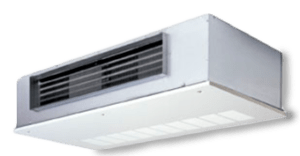
- Decorative Exposed Ceiling Unit:
This unit is mounted in the space and has a painted decorative outer casing all around it. The normal arrangement is a bottom grilled return and a grilled supply out the front of the unit. There is always a hinged bottom access into the unit from underneath.
Vertical Floor and Wall Units:
- Basic Floor Exposed Units
This is a unit that has a decorative case, covering the unit entirely. Typically, return air enters at the bottom front of the unit and supply air enters through the grilled top discharge. These units have filters, coil(s), and direct driven fans and motors. There is usually space for electrical controls and wiring on one end of the unit and valving on the other end. These units are normally about 25” high and extend 9” to 10” out from the wall.
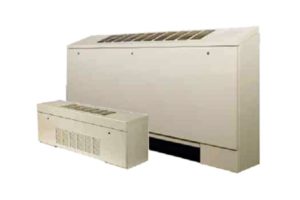
- Slope Top Floor Exposed Units
This unit is the same as the basic floor exposed unit, except the discharge for supply air is at a 45-degree angle rather than straight up air flow discharge.
- Basic Recessed Units
These units are less decorative cabinets and are located within the wall or decorative special cabinet at the floor level.
- Low Boy Floor Exposed Units
This unit style has all the same components as the basic floor exposed units, but they are shorter in height and are usually deeper out from the wall. Many times, they are located where a lower silhouette unit is required due to windows or glass extending almost the entire height of the wall.
- Wall Mounted Units
These unit are hung off the wall and can be fully exposed or partially contained inside the wall. They have filters, coils, and direct connected fan-motor arrangement.
- Vertical Closet and Recessed Vertical Hi-rise Units
These units all have insulted cabinets that vary in height, width, and depth. They can have bottom or front returns and either top or front discharges. Whenever the unit is a front inlet or outlet, most times that arrangement is grilled type. Hi-Rise units include the vertical unit, chilled and hot water supply and return piping, along with condensate removal.
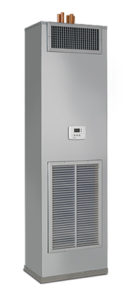
Accessories:
The cost basis for most projects is the more accessories the factory supplies with the units, it will be less expensive than field-supplied labor costs.
- Wall or unit mounted controls to include speed switches, all types of thermostats, disconnects, and transformers for line to control voltage
- Valve packages to include two and three types, flow control, ball valves, strainers, and many other piping package requirements
- Decorative grilles and painted cabinets
- Efficiently designed ECM motors that provide quality payback over time
Replacement and Retrofit Projects:
As an installer once told me, “I have never been to an existing facility where the people were too cold or too warm from the cooling and heating units”. That statement tells all of us that in almost every existing system there are huge temperature and air distribution problems, and the tenants and owners have had to live with these problems for years. When replacing units, it’s very important to assess the problems and determine if some or all these problems can be alleviated with new units.
USA Coil & Air offers various types of fan coil units, arrangements, and accessories to go along with them. We have a retrofit mindset and 5+ decades of knowledge and experience working with fan coil unit owners to alleviate inherent problems in their systems. We are the “specialists” in replacing older units.
USA Coil & Air pioneered a new patent-pending fan coil unit designed for high humidity areas in the world called the “Tri-coil”. If normal fan coil units don’t remove the humidity within a space during peak load times, we may have your answer. Most fan coil units can’t handle tropical temperature and humidity load. Our unique design may be just what you need to improve your system. If you are in Southern Florida, the Caribbean, Mexico, Hawaii, or any place where this problem exists; call us and take advantage of our expertise and experience.
